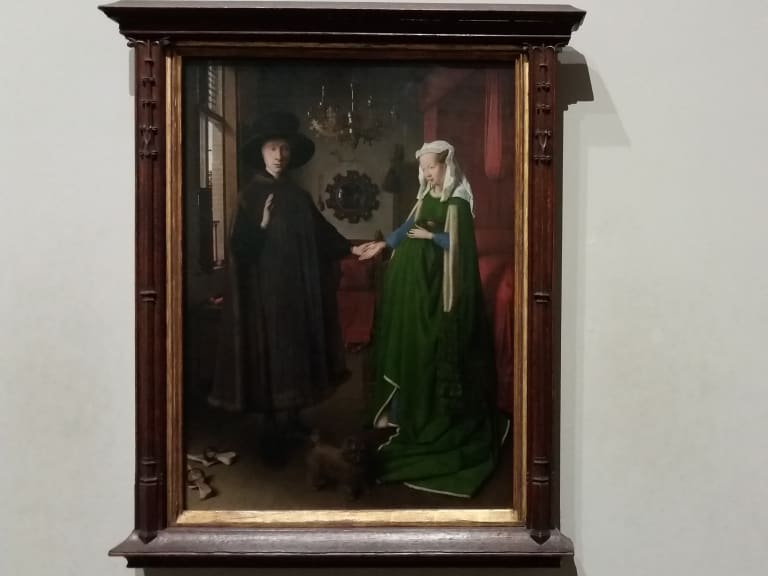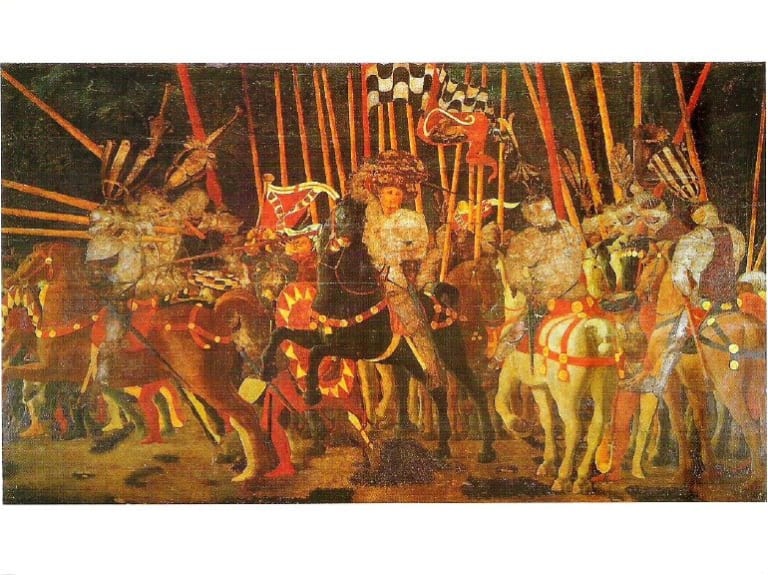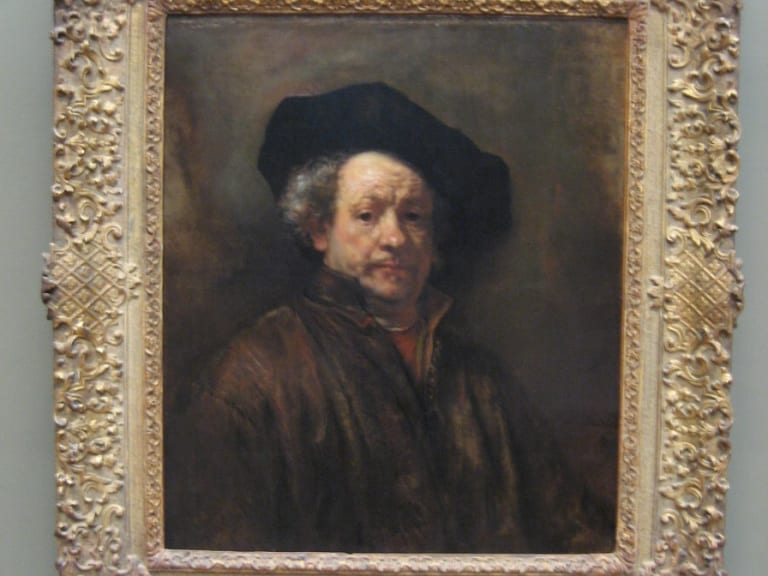More about: 12 Best Paintings of the National Gallery of London
Are you an art lover? Titian's Bacchus and Ariadne, Velázquez's Venus at her Mirror, Van Gogh's Sunflowers, Rembrandt's Self-Portrait, Turner's The Fighting Ship, and 2,300 other paintings and frescoes are currently on display at the National Gallery in London.
Founded in 1824 with just 38 paintings, it became the true jewel in the crown with its remarkable representation of the best of the 13th to the 20th centuries in England. But what are its best works? In this post, I share with you the top paintings that you cannot miss, according to the experts, ordered by their year of creation. Let's get started!
1. "The Arnolfini Marriage" by Jan van Eyck, 1434

This masterpiece by Jan van Eyck is one of the most enigmatic pieces in the history of art. It is not just any portrait, it is a masterpiece! And it has a turbulent history of travel, theft and looting. It was Ferdinand VII who recovered it and gave it to England.
This painting, which you will have the opportunity to see if you book a guided tour of the National Gallery in London, has hundreds of interpretations of its symbolism and is one of the most compelling representations of people of the time in their home. The painting is one of the jewels of the 30 most famous museums in the world.
Interesting details
- Location: Room 28.
- Why it stands out: for its light, shadow and meticulous attention to detail.
- Interesting fact: full-length portraits were rarely painted in the 15th century.
2. "The Battle of San Romano" by Paolo Uccello, 1440

Paolo Uccello was a Renaissance painter known for his use of perspective and foreshortening, as well as his ability to capture intricate details in his paintings. This is evident in this work, which you can see on the guided tour of the National Gallery in London
It is one of the 100 best paintings in London according to TimeOut. The three panels depicting the battle were supposedly commissioned by the Medici family, who kept them in their possession until the last days of Lorenzo de Medici in 1492.
Interesting details
- Location: Room 54.
- Why it stands out: the horse of Tolentino was painted in such detail that it seems to be charging towards the viewer.
- Interesting fact: it depicts a battle between Florentine and Sienese soldiers.
3. "The Doge Leonardo Loredan" by Giovanni Bellini, 1501

On the guided tour of the National Gallery in London, you will also see one of the most important works of the Italian Renaissance. Painted in 1501, when Venice was at the height of its power as a European capital and the Bellini family dominated the art scene.
The painting depicts the doge or "supreme magistrate" of the oligarchy that ruled Venice. The man's features are immobile and reflect almighty Roman traits. The light illuminates the entire surface, especially the ostentatious gold and silver damasks from Turkey. If you look closely at the painting, you will appreciate the different layers of oil that make up its relief.
Details of interest
- Location: room 62.
- Why it stands out: play of light and shadow.
- Interesting fact: it is a perfect example of the union between art and power during that period.
4. "Madonna of the Pinks" by Raphael, 1507

On your guided tour of the National Gallery in London, you will also admire this composition inspired by a work by Da Vinci entitled Madonna Benois. Ranked as one of the 10 must-see works in the National Gallery in London according to the experts at Arte & Subastas.
In this painting, Raphael depicts the Virgin Mary as a young and beautiful woman with a relaxed expression symbolising her closeness to humanity. She wears an elegant dress with wide sleeves and a fur cloak over her shoulders. The Virgin's right hand rests on her lap and holds a carnation or rosebud in front of her chest.
Details of interest
- Location: Room 8.
- Why it stands out: one of the most important works preserved from this passage.
- Interesting fact: some people know this painting as The Virgin of the Roses.
5. "The Virgin of the Rocks" by Leonardo da Vinci, 1508

During your visit to the National Gallery, you will also see this mystical painting. There are two works with the same name. The first dates from 1486 and is on display at the Louvre Museum. The second (this one) was painted a decade later. According to the curators, the central narrative of the painting revolves around a pale-skinned Virgin who has just emerged from a cave, but there are two theories:
- The first suggests that the Virgin is blessing humanity as she leaves the cave.
- The second leans towards a more humanistic view, following Plato's myth of the cave.
Which theory is correct? Well, that is one of the many enigmas to be solved in The Da Vinci Code.
Interesting details
- Location: Room 9.
- Why it stands out: it is in the top 20 most visited paintings in the National Gallery in London.
- Interesting fact: it is possible that Giovanni Ambrogio de Predis, Da Vinci's assistant, was the actual author of the work.
6. "Bacchus and Ariadne" by Titian, 1523

One of the must-sees for children visiting the National Gallery is this impressive oil painting depicting Bacchus, the Roman god of wine, and his madness in search of his lost lover, Ariadne. The painting is part of a series of frescoes and mythological paintings for the Alabaster Chamber.
On the left-hand side, the skilled painter recreates the mythological origin of the Northern Constellation, as Zeus' wedding gift was to turn the bride's crown into this grouping of stars.
Details of interest
- Location: room number 10.
- Why it stands out: harmony of colour.
- Interesting fact: it was created in 1523 for Alfonso I of Este, Duke of Ferrara.
7. "Self-Portrait" by Van Rijn Rembrandt, 1640

Van Rijn Rembrandt was at the height of his career when he painted Self-Portrait at the age of 34. He was the most famous painter in Holland and rubbed shoulders with the most exclusive social circles.
The artist depicts a nobleman of high status, imposing character, vast wealth and the power conferred on him by his artistic and humanistic gifts, although we cannot overlook the fact that fortune smiled on him later when he married his cousin Saskia.
Rembrandt was a specialist in portraying the traditions of high society, particularly in group portraits.
Details of interest
- Location: room 23.
- Why it stands out: his contribution to Baroque art is acclaimed internationally, as confirmed, for example, by the famous sculptor Auguste Rodin.
- Interesting fact: 29 years later, after Saskia's death, in his "Self-Portrait at the Age of 63", the image is very different from the original.
8. "Venus at her Mirror" by Diego Velázquez, 1651

Who is the woman in the painting? Experts have not been able to solve the mystery, but what is certain is that the work you will see on your visit to the National Gallery belongs to the Spanish master of Baroque painting, Diego Velázquez.
Venus in the Mirror is one of the most interesting paintings dedicated to femininity, painted, perhaps, during the artist's second trip to Italy. The artist was not particularly interested in the face of this goddess as he worked brushstroke by brushstroke on the "Rokeby". Essentially, it was feminine beauty that he wanted to portray.
Details of interest
- Location: Room 30.
- Why it stands out: it is the only surviving nude by the Sevillian painter.
- Interesting fact: the personification of love seems to follow her curves.
9. "Young Woman Seated at a Virginal" by Johannes Vermeer, 1672

The translation of this painting, which you will see on your visit to the National Gallery, is quite controversial. Some call it Young Lady Standing at a Spinet, others Young Lady Standing at a Spinet, also Young Woman Seated at a Spinet or Lady Seated at a Spinet.
The master of light and silence is known for his use of colour, the serenity of his works, and his work with light and shadow, as in this case, where he consciously reduced his palette to contrast textures.
This painting is among the top 20 most visited works in the National Gallery in London, according to the gallery's report.
Details of interest
- Location: Room 25.
- Why it stands out: it is an excellent example of Dutch Golden Age painting.
- Interesting fact: Johannes Vermeer's most famous painting is Girl with a Pearl Earring, as portrayed by Scarlett Johansson and Colin Firth in the 2003 film of the same name.
10. "The Hay Wain" by John Constable, 1821

With an exquisite depiction of a scene between Suffolk and Essex, Constable shows why he is considered one of the precursors of Impressionism.
Despite his revolutionary vision and the gold medal he won in Paris for this painting, it took a century before the detail of Constable's work was appreciated.
Details of interest
- Location: Room 34.
- Why it stands out: the detail.
- Interesting fact: it was voted the second most beautiful painting in the National Gallery in London.
11. "The Foolhardy" by William Turner, 1839

This painting, which you can admire during your visit to the National Gallery, is an impressive example of Joseph Mallord William Turner's mastery of light and colour. The scene is a sunset against the backdrop of a sky so blurred that it almost seems like an illusion. In the best romantic style, this expert landscape painter captures the glory days of sailing ships in his work, while also recalling the end of their golden age.
The ship being towed along the Thames is called The Foolhardy, and it is arriving at its destination to be scrapped after the Battle of Trafalgar in 1805. The tugboat pulling it has a dark silhouette in the foreground, and the artist does not intend to make an exact replica of the original, as the intention was to reflect the nostalgia and loss of the transition from the agricultural era to the Industrial Revolution.
Details of interest
- Location: room number 34.
- Why it stands out: the light and colour
- Interesting fact: on the eve of the 200th anniversary of the National Gallery in London, a survey was conducted among critics and visitors to find the best work in the gallery, and this was the winning painting.
12. "Sunflowers" by Vincent Van Gogh, 1888

Of course, one of the things to see and do in London is to see Sunflowers, a curious painting that stands out for its structure and almost illegible signature near a delicate blue line, more typical of the craftsman who made the vase than of the co-founder of post-impressionism.
Vincent van Gogh, in his quest to become a disciple of Paul Gauguin, created this series of paintings to impress him, although the story quickly took a dark turn, leaving the father of modern art immersed in sadness and madness until the end of his days, at the age of only 37.
Interesting details
- Location: room 46.
- Why it stands out: the intense presence of yellow, the painter's distinguishing feature.
- Interesting fact: it is one of only three original works featuring 15 sunflowers in the world.
















